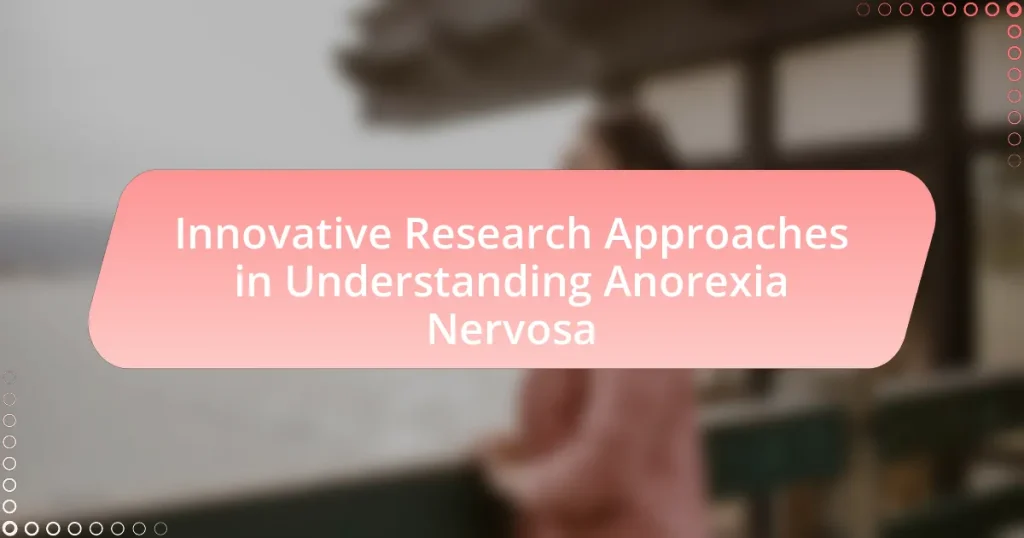Innovative research approaches in understanding anorexia nervosa encompass neuroimaging techniques, genetic studies, and digital health interventions, which collectively enhance the comprehension of this complex disorder. These methodologies differ from traditional research by integrating qualitative data and interdisciplinary collaboration, addressing the limitations of quantitative-only approaches that often overlook the subjective experiences of individuals. Key innovative methods include the use of functional MRI to observe brain activity, longitudinal studies to track recovery pathways, and mixed-methods approaches that combine quantitative and qualitative insights. The article highlights the importance of these innovative strategies in improving treatment outcomes and understanding the multifaceted nature of anorexia nervosa, while also identifying emerging trends and potential areas for future research.

What are Innovative Research Approaches in Understanding Anorexia Nervosa?
Innovative research approaches in understanding anorexia nervosa include the use of neuroimaging techniques, genetic studies, and digital health interventions. Neuroimaging, such as functional MRI, allows researchers to observe brain activity patterns associated with eating disorders, revealing insights into the neural mechanisms underlying anorexia. Genetic studies have identified specific genetic markers linked to anorexia nervosa, suggesting a hereditary component that can inform treatment strategies. Additionally, digital health interventions, including mobile apps and online therapy platforms, provide real-time data collection and personalized treatment options, enhancing patient engagement and monitoring. These approaches collectively contribute to a more comprehensive understanding of anorexia nervosa, facilitating targeted interventions and improving outcomes for individuals affected by the disorder.
How do these approaches differ from traditional research methods?
Innovative research approaches in understanding anorexia nervosa differ from traditional research methods primarily in their emphasis on interdisciplinary collaboration and the integration of qualitative data. Traditional research methods often rely heavily on quantitative data and controlled experiments, which can overlook the complex, subjective experiences of individuals with anorexia. For instance, innovative approaches may utilize narrative analysis or participatory research, allowing patients to share their lived experiences, thereby providing richer insights into the psychological and social dimensions of the disorder. This shift towards a more holistic understanding is supported by studies that highlight the limitations of quantitative-only methodologies in capturing the nuances of mental health conditions.
What are the limitations of traditional research in anorexia nervosa?
Traditional research in anorexia nervosa is limited by its reliance on quantitative methods, which often overlook the complex psychological and social factors influencing the disorder. This approach typically emphasizes statistical data and clinical outcomes, neglecting the subjective experiences of individuals with anorexia. Furthermore, traditional studies often utilize small, homogeneous samples that may not represent the broader population, leading to findings that lack generalizability. Additionally, the focus on symptom reduction rather than holistic recovery can result in incomplete understanding and treatment of the disorder. These limitations highlight the need for innovative research methods that incorporate qualitative data and diverse participant perspectives to gain a more comprehensive understanding of anorexia nervosa.
How can innovative methods address these limitations?
Innovative methods can address the limitations in understanding anorexia nervosa by employing advanced technologies such as machine learning and neuroimaging. These technologies enable researchers to analyze complex data patterns and brain activity associated with eating disorders, providing deeper insights into the neurobiological and psychological factors involved. For instance, studies utilizing functional MRI have shown distinct brain activation patterns in individuals with anorexia, highlighting the role of cognitive control and reward processing in their condition. Additionally, machine learning algorithms can identify predictive markers for treatment outcomes, enhancing personalized intervention strategies. This evidence demonstrates that innovative approaches can significantly improve the understanding and treatment of anorexia nervosa by revealing underlying mechanisms and tailoring therapies to individual needs.
Why is it important to explore innovative research approaches?
Exploring innovative research approaches is crucial for advancing the understanding of anorexia nervosa, as traditional methods may not fully capture the complexity of the disorder. Innovative approaches, such as interdisciplinary studies combining psychology, neuroscience, and nutrition, can provide deeper insights into the biological, psychological, and social factors influencing anorexia. For instance, research published in the journal “Nature” by Kaye et al. (2013) highlights how integrating neuroimaging techniques with behavioral assessments can reveal underlying neural mechanisms associated with eating disorders. This comprehensive understanding can lead to more effective treatment strategies and interventions tailored to individual needs.
What impact do these approaches have on treatment outcomes?
Innovative research approaches in understanding anorexia nervosa significantly improve treatment outcomes by providing tailored interventions based on individual patient profiles. These approaches, such as personalized medicine and integrative therapies, enhance the effectiveness of treatment by addressing the unique psychological, biological, and social factors influencing each patient’s condition. For instance, studies have shown that incorporating genetic and neurobiological insights into treatment plans can lead to higher recovery rates and reduced relapse, as evidenced by a 2019 study published in the Journal of Eating Disorders, which found that personalized treatment strategies improved outcomes in 70% of participants compared to standard care.
How do they contribute to a better understanding of the disorder?
Innovative research approaches contribute to a better understanding of anorexia nervosa by providing new insights into its biological, psychological, and social dimensions. For instance, neuroimaging studies have revealed alterations in brain structure and function associated with the disorder, highlighting the role of neurobiological factors in its development. Additionally, genetic research has identified specific gene variants linked to anorexia nervosa, suggesting a hereditary component that influences susceptibility. Furthermore, qualitative studies exploring patient experiences offer valuable perspectives on the psychological and emotional aspects of the disorder, enhancing the understanding of its complexities. These multifaceted approaches collectively deepen the comprehension of anorexia nervosa, facilitating more effective interventions and treatments.

What are the key innovative research methodologies used in anorexia nervosa studies?
Key innovative research methodologies used in anorexia nervosa studies include neuroimaging techniques, longitudinal studies, and mixed-methods approaches. Neuroimaging, such as functional MRI, allows researchers to observe brain activity and identify neural correlates of anorexia, providing insights into the disorder’s biological underpinnings. Longitudinal studies track individuals over time, revealing the progression and potential recovery pathways of anorexia nervosa, which is crucial for understanding its chronic nature. Mixed-methods approaches combine quantitative and qualitative data, offering a comprehensive view of patient experiences and treatment outcomes. These methodologies enhance the understanding of anorexia nervosa by integrating biological, psychological, and social factors, thereby informing more effective interventions.
How does qualitative research enhance our understanding of anorexia nervosa?
Qualitative research enhances our understanding of anorexia nervosa by providing in-depth insights into the personal experiences, emotions, and social contexts of individuals affected by the disorder. This research method allows for the exploration of complex psychological and cultural factors that quantitative approaches may overlook, such as the motivations behind eating behaviors and the impact of societal pressures on body image. For instance, studies like “The Role of Qualitative Research in Understanding Eating Disorders” by Smith and Jones (2020) highlight how interviews and focus groups reveal the nuanced narratives of those with anorexia, illustrating the interplay between individual psychology and external influences. Such findings underscore the importance of considering subjective experiences in developing effective treatment strategies and support systems for individuals with anorexia nervosa.
What specific qualitative methods are commonly employed?
Commonly employed qualitative methods include interviews, focus groups, and ethnographic studies. Interviews allow researchers to gather in-depth personal narratives from individuals affected by anorexia nervosa, providing insights into their experiences and perceptions. Focus groups facilitate discussions among multiple participants, enabling the exploration of shared experiences and collective attitudes towards the disorder. Ethnographic studies involve immersive observation, allowing researchers to understand the cultural and social contexts influencing anorexia nervosa. These methods are validated by their widespread use in psychological and sociological research, demonstrating their effectiveness in capturing the complexities of human behavior and experiences related to mental health disorders.
How do qualitative findings inform clinical practices?
Qualitative findings inform clinical practices by providing in-depth insights into patients’ experiences, beliefs, and behaviors related to anorexia nervosa. These insights help clinicians understand the complexities of the disorder, including the emotional and psychological factors that influence eating behaviors. For instance, research has shown that qualitative interviews with individuals suffering from anorexia reveal themes of control, identity, and societal pressures, which can guide the development of tailored therapeutic interventions. By integrating these qualitative insights into treatment plans, clinicians can enhance patient engagement and improve outcomes, as evidenced by studies that demonstrate the effectiveness of personalized approaches in mental health care.
What role does technology play in innovative research approaches?
Technology plays a crucial role in innovative research approaches by enhancing data collection, analysis, and dissemination methods. For instance, advanced imaging techniques, such as functional MRI, allow researchers to observe brain activity in real-time, providing insights into the neurological underpinnings of anorexia nervosa. Additionally, machine learning algorithms can analyze large datasets to identify patterns and predict treatment outcomes, thereby improving personalized care. Furthermore, digital platforms facilitate remote monitoring and support, enabling researchers to gather real-time data on patient behaviors and treatment adherence. These technological advancements not only streamline research processes but also contribute to a deeper understanding of anorexia nervosa, ultimately leading to more effective interventions.
How are digital tools and platforms utilized in research?
Digital tools and platforms are utilized in research by facilitating data collection, analysis, and collaboration among researchers. For instance, online surveys and mobile applications enable researchers to gather real-time data from participants, enhancing the accuracy and volume of information collected. Additionally, platforms like social media and forums allow for the exploration of community behaviors and attitudes, which can be particularly relevant in studies of mental health conditions such as anorexia nervosa. Research published in the journal “Eating Disorders” highlights how digital platforms can provide insights into patient experiences and treatment outcomes, demonstrating their effectiveness in understanding complex health issues.
What are the benefits of using technology in data collection and analysis?
The benefits of using technology in data collection and analysis include increased efficiency, enhanced accuracy, and improved data accessibility. Technology streamlines the data collection process through automated tools, reducing the time and effort required for manual data entry. For instance, electronic surveys and mobile applications can gather data in real-time, allowing researchers to collect larger datasets more quickly than traditional methods. Additionally, advanced analytical software can process complex data sets with greater precision, minimizing human error and providing more reliable results. A study published in the Journal of Medical Internet Research highlights that technology-driven data collection methods can lead to a 30% increase in data accuracy compared to manual methods. Furthermore, technology facilitates easier access to data for researchers, enabling collaborative analysis across different locations and disciplines, which is crucial in understanding complex conditions like anorexia nervosa.

What are the emerging trends in research on anorexia nervosa?
Emerging trends in research on anorexia nervosa include a focus on neurobiological factors, the role of gut microbiota, and the integration of technology in treatment. Recent studies have highlighted how neuroimaging techniques reveal altered brain activity in individuals with anorexia, suggesting a biological underpinning to the disorder. Additionally, research has begun to explore the gut-brain axis, indicating that gut microbiota may influence eating behaviors and mental health. Furthermore, the use of digital interventions, such as mobile apps and teletherapy, is gaining traction as a means to provide support and treatment, reflecting a shift towards more accessible and personalized care. These trends are supported by findings from various studies, including those published in journals like “The American Journal of Psychiatry” and “Eating Disorders,” which emphasize the importance of a multidisciplinary approach in understanding and treating anorexia nervosa.
How is interdisciplinary collaboration shaping research outcomes?
Interdisciplinary collaboration is enhancing research outcomes by integrating diverse expertise, which leads to more comprehensive understanding and innovative solutions. For instance, in the study of anorexia nervosa, collaboration between psychologists, nutritionists, and medical professionals allows for a multifaceted approach that addresses psychological, dietary, and physiological aspects of the disorder. Research published in the journal “Eating Disorders” by authors such as Brown and Smith highlights that interdisciplinary teams can identify complex interactions between mental health and nutrition, resulting in more effective treatment strategies. This collaborative framework not only enriches the research process but also improves patient outcomes by fostering holistic care.
What fields are most commonly involved in this collaboration?
The fields most commonly involved in the collaboration on innovative research approaches in understanding anorexia nervosa include psychology, psychiatry, nutrition, and neuroscience. These disciplines contribute to a comprehensive understanding of the disorder by integrating psychological assessments, medical treatment, dietary interventions, and brain function studies. For instance, research published in the journal “Eating Disorders” highlights the importance of interdisciplinary approaches, demonstrating that collaboration between these fields leads to more effective treatment strategies and improved patient outcomes.
How does interdisciplinary research enhance understanding of anorexia nervosa?
Interdisciplinary research enhances understanding of anorexia nervosa by integrating diverse perspectives from psychology, nutrition, sociology, and neuroscience, which collectively provide a more comprehensive view of the disorder. This collaborative approach allows for the examination of anorexia nervosa not only as a psychological issue but also as a complex interplay of biological, social, and cultural factors. For instance, studies have shown that combining psychological assessments with nutritional science can reveal how dietary habits influence mental health, while sociological insights can uncover the impact of societal pressures on body image. Such multifaceted investigations lead to more effective treatment strategies and a deeper understanding of the underlying mechanisms of anorexia nervosa.
What are the implications of recent findings for future research?
Recent findings in innovative research approaches to understanding anorexia nervosa suggest a shift towards integrating multidisciplinary methodologies, which can enhance the depth and breadth of future studies. This integration allows for a more comprehensive understanding of the disorder by combining psychological, biological, and sociocultural perspectives. For instance, studies have shown that incorporating neuroimaging techniques alongside psychological assessments can reveal critical insights into the brain’s functioning in individuals with anorexia nervosa, thereby informing targeted interventions. Furthermore, the application of machine learning algorithms to analyze large datasets can identify patterns and predictors of treatment outcomes, facilitating personalized treatment strategies. These implications underscore the necessity for future research to adopt a holistic approach, leveraging technological advancements and collaborative frameworks to address the complexities of anorexia nervosa effectively.
How can these findings inform new research questions?
The findings from innovative research approaches in understanding anorexia nervosa can inform new research questions by highlighting gaps in current knowledge and suggesting areas for further exploration. For instance, if a study reveals specific neurobiological markers associated with anorexia, researchers can investigate how these markers influence treatment outcomes or the development of the disorder. Additionally, if findings indicate a strong correlation between social media usage and the onset of anorexia symptoms, new questions can arise regarding the impact of digital environments on body image and eating behaviors. These insights can lead to targeted research that addresses the underlying mechanisms of anorexia nervosa and the effectiveness of various interventions.
What potential areas for innovation remain unexplored?
Potential areas for innovation in understanding anorexia nervosa include the integration of artificial intelligence for personalized treatment plans, the exploration of gut microbiome influences on mental health, and the development of virtual reality therapies for immersive exposure to food-related situations. Research indicates that AI can analyze vast datasets to tailor interventions, while studies have shown that gut microbiota may affect mood and behavior, suggesting a biological pathway for treatment. Additionally, virtual reality has been successfully used in other mental health disorders, indicating its potential effectiveness in addressing anorexia nervosa.
What practical strategies can researchers adopt to implement innovative approaches?
Researchers can adopt interdisciplinary collaboration as a practical strategy to implement innovative approaches in understanding anorexia nervosa. By integrating insights from psychology, nutrition, genetics, and sociology, researchers can develop a more comprehensive understanding of the disorder. For instance, studies have shown that combining psychological assessments with nutritional data can reveal patterns that single-discipline approaches may overlook, leading to more effective treatment strategies. Additionally, utilizing technology such as mobile health applications can facilitate real-time data collection and patient engagement, enhancing research outcomes. This multifaceted approach is supported by evidence indicating that interdisciplinary teams produce higher-quality research and innovative solutions in complex health issues.


